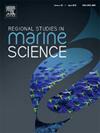Multiscale climate forcing on green and hawksbill turtle nesting dynamics in Malaysia
IF 2.1
4区 环境科学与生态学
Q3 ECOLOGY
引用次数: 0
Abstract
Sea turtles play critical roles in marine ecosystems, yet they face numerous threats, not only of anthropogenic origin but also those exacerbated by environmental changes. This study investigates the impacts of both local and global climatic forcing on green (Chelonia mydas) and hawksbill (Eretmochelys imbricata) turtle populations in Malaysia. Using 17 years of nesting data from Tioman Island, we examined nesting abundance, spatial distribution, temporal trends, and egg abundance in relation to local climatic conditions (temperature and precipitation) and global climatic conditions (El Niño Southern Oscillation – ENSO), through Wavelet Analysis. Our study demonstrates that both local and global climate variables significantly influence turtle egg abundance, with local factors driving short-term seasonal variability and global factors like ENSO affecting long-term multiannual cycles. Additionally, we found that warmer temperatures during El Niño events negatively impact green turtles egg abundance 2 years and a half later but positively impact hawksbill turtles 2 years post–event. These contrasting responses emphasize species-specific reproductive adaptations to climatic variability. Understanding these dynamics is critical for developing adaptive conservation strategies that mitigate the effects of climate change and promote sustainable population management for both species.
求助全文
约1分钟内获得全文
求助全文
来源期刊

Regional Studies in Marine Science
Agricultural and Biological Sciences-Ecology, Evolution, Behavior and Systematics
CiteScore
3.90
自引率
4.80%
发文量
336
审稿时长
69 days
期刊介绍:
REGIONAL STUDIES IN MARINE SCIENCE will publish scientifically sound papers on regional aspects of maritime and marine resources in estuaries, coastal zones, continental shelf, the seas and oceans.
 求助内容:
求助内容: 应助结果提醒方式:
应助结果提醒方式:


